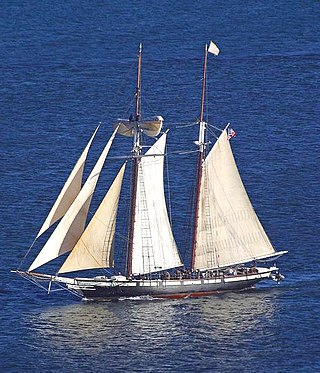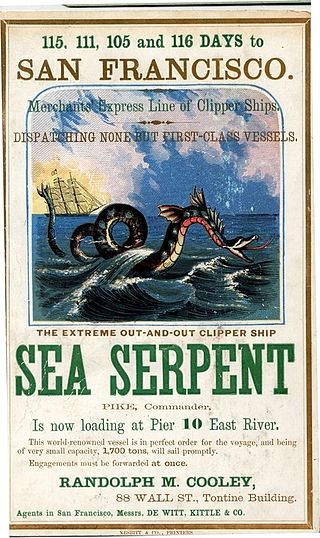
A clipper was a type of mid-19th-century merchant sailing vessel, designed for speed. Clippers were generally narrow for their length, small by later 19th century standards, could carry limited bulk freight, and had a large total sail area. "Clipper" does not refer to a specific sailplan; clippers may be schooners, brigs, brigantines, etc., as well as full-rigged ships. Clippers were mostly constructed in British and American shipyards, although France, Brazil, the Netherlands and other nations also produced some. Clippers sailed all over the world, primarily on the trade routes between the United Kingdom and China, in transatlantic trade, and on the New York-to-San Francisco route around Cape Horn during the California Gold Rush. Dutch clippers were built beginning in the 1850s for the tea trade and passenger service to Java.

Royal Clipper is a steel-hulled five-masted fully rigged tall ship used as a cruise ship. She was redesigned by Robert McFarlane of McFarlane ShipDesign, for Star Clippers Ltd. of Sweden, the same designer behind the cruise company's first two vessels. This third one was built using an existing steel hull designed by Zygmunt Choreń that was modified by the Gdańsk Shipyard, where 24 metres (79 ft) was added to its length.

Marco Polo was a three-masted wooden clipper ship, launched in 1851 at Saint John, New Brunswick. She was named after Venetian traveler Marco Polo. The ship carried emigrants and passengers to Australia and was the first vessel to make the round trip from Liverpool in under six months. Later in her career, the ship was used as a cargo ship before running aground off Cavendish, Prince Edward Island, in 1883.

Ariel was a clipper ship famous for making fast voyages between China and England in the late 1860s. She is most famous for almost winning The Great Tea Race of 1866, an unofficial race between Fuzhou, China and London with the first tea crop of the 1866 season.

The Pride of Baltimore was a reproduction of a typical early 19th-century "Baltimore clipper" topsail schooner. This was a style of vessel made famous by its success as a privateer commerce raider, a small warship in the War of 1812 (1812–1815) against British merchant shipping and the world-wide British Royal Navy. After the end of the war, Baltimore Clippers did not have sufficient cargo capacity for normal merchant trade, so some were used in the illegal opium trade into China and vessels of the same type were used in the transatlantic slave trade from Africa.

A Baltimore Clipper is a fast sailing ship historically built on the mid-Atlantic seaboard of the United States of America, especially at the port of Baltimore, Maryland. An early form of clipper, the name is most commonly applied to two-masted schooners and brigantines. These vessels may also be referred to as Baltimore Flyers.

HMS Pelorus was an 18-gun Cruizer-class brig-sloop of the British Royal Navy. She was built in Itchenor, England and launched on 25 June 1808. She saw action in the Napoleonic Wars and in the War of 1812. On anti-slavery patrol off West Africa, she captured four slavers and freed some 1350 slaves. She charted parts of Australia and New Zealand and participated in the First Opium War (1839–1842) before becoming a merchantman and wrecking in 1844 while transporting opium to China.

When launched in 1853, Great Republic was the largest wooden ship in the world. She shared this title with another American-built ship, the steamship Adriatic. She was also the largest full-rigged ship ever built in the United States. She was built by Donald McKay for trade on his own account to Australia.

In the middle third of the 19th century, the clippers which carried cargoes of tea from China to Britain would compete in informal races to be first ship to dock in London with the new crop of each season. The Great Tea Race of 1866 was keenly followed in the press, with an extremely close finish. Taeping docked 28 minutes before Ariel - after a passage of more than 14,000 miles. Ariel had been ahead when the ships were taken in tow by steam tugs off Deal, but after waiting for the tide at Gravesend the deciding factor was the height of tide at which one could enter the different docks used by each ship. The third finisher, Serica, docked an hour and 15 minutes after Ariel. These three ships had left China on the same tide and arrived at London 99 days later to dock on the same tide. The next to arrive, 28 hours later, was Fiery Cross, followed, the next day, by Taitsing.

Sea Serpent was an 1850 extreme clipper that sailed in the San Francisco trade, the China trade, and the transatlantic lumber trade. She was one of the longest lived clippers, with a service life of 36 years and 5 months.

Golden Fleece was an 1855 medium clipper in the California trade, built by Paul Curtis. She was known for arriving with cargoes in good condition, for making passages in consistently good time, and for catching fire with a load of ice.

Sylph was a clipper ship built at Sulkea, opposite Calcutta, in 1831 for the Parsi merchant Rustomjee Cowasjee. After her purchase by the Hong Kong-based merchant house Jardine Matheson, in 1833 Sylph set a speed record by sailing from Calcutta to Macao in 17 days, 17 hours. Her primary role was to transport opium between various ports in the Far East. She disappeared en route to Singapore in 1849.
The schooner Anglona was the first American opium clipper. She sailed in the Chinese coastal trade in the 1840s, and had a famous race with the schooner Ariel around Lintin Island.

Lahloo was a British tea clipper known for winning the Tea Race of 1870, and finishing second in the Tea Race of 1871. She sailed from Fuzhou to London with over a million pounds of tea in 1868.

Lord of the Isles was the first iron-hulled tea clipper, built in Greenock in 1853. She served in the tea trade until 1862, and also made voyages to Australia. She is known for a record passage between Greenock and Shanghai, and for her close finish in the 1856 Tea Race from China to England, docking in London just ten minutes before Maury. This race was the basis for the plot of a 1927 movie by Cecil B. DeMille The Yankee Clipper.
Zephyr was an 1842 opium clipper built by Samuel Hall, East Boston that was known for its speed.

Yatala was a British clipper ship that was built in England in 1865 and wrecked on the north coast of France in 1872. She spent her seven-year career with Anderson, Thomson and Co's Orient Line, sailing between London and South Australia.

The SS Schomberg was a clipper built in Aberdeen by Alexander Hall & Co. for "the Black Ball line" for carrying large cargoes and steerage passengers, and to "outdo the Americans". When built, she was regarded as the most luxurious and well-built clipper of the period.
Kaisow, a composite clipper, was built by Robert Steele & Company at Greenock and launched on 19 November 1868.















